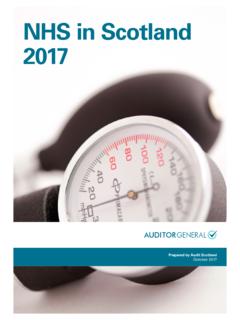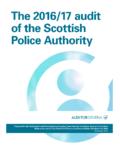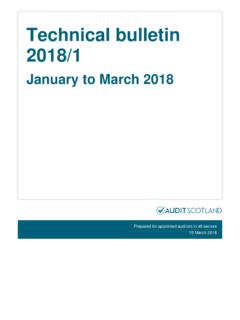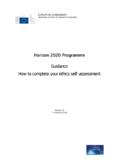Transcription of Assess yourself - using self assessment for …
1 ,~,..-~ ,..lI ~'"..I _ .._r"__~AccountsWCommissionfor ScotlandMAY 1998 This paper is structured as follows:Introduction12 Continuous improvement and self assessment23 self assessment44 Group self assessment65 Getting started - success factors86 assessment to action11- generating and prioritising ideas7 Getting more from the management19arrangements modules8 Conclusion209 References and further Accounts Commission is a statutory, independentbody which, through the audit process, assists localauthorities and the health service in Scotland toachieve the highest standards of financial stewardshipand the economic, effcient and effective use of Commission has five main responsibilities:. securing the external audit. following up issues of concern identified throughthe audit, to ensure satisfactory resolutions.
2 Reviewing the management arrangements whichaudited bodies have in place to achieve value formoney. carrying out national value for money studies toimprove economy, effciency and effectiveness inlocal government and the NHS. issuing an annual direction to local authoritieswhich sets out the range of performanceinformation which they are required to Commission secures the audit of 32 councils, 36joint boards (including police and fire services), 15health boards, 47 NHS trusts and five other NHSbodies. In total these organisations spend publicfunds worth around 12 bilion a is the first in a series a series of managementpapers being produced by the Management StudiesUnit at the Accounts Commission for Scotland. Thesepapers are intended to support best practice in publicsector management by disseminating ideas,approaches and techniques which managers shouldfind Unit welcomes paper was written by Diane you would like further information on thispublication please contactDiane McGiffenManagement Studies UnitAccounts Commission for Scotland18 George StreetEdinburghEH22 QUAccounts Commission/Local Government/i&\e\g(OC~3)Management ArrangementsModules1: Corporate and serviceplanning and budgetarycontrol2: Managing people3: Managing resources4: Organisational design1)0 14((u,-/J~ (~.))
3 -VV'~~ \~-"j Lo(ul Gou+-( I c,'1 "i IntroductionThis paper describes how self assessment can be used to promote improvedperformance in local authorities and contribute to continuous improvement. It isintended for managers using the Accounts Commission management draws on the experience of self assessment in the private and public sectors andsets out some practical tools that managers can employ to get the most out of selfassessment assessment underpins many quality and performance improvement initiativesand can be used by managers to improve understanding of their organisations and toidentify opportunities for continuous improvement. Continuous improvement iscentral to the Accounts Commission's management arrangements audits and to theBest Value 1997, the Accounts Commission launched two self assessment modules for theaudit of local authority management arrangements.))
4 This approach represents a newdevelopment in the audit of local authorities. The audit is structured as a selfassessment audit to support continuous improvement. Managers Assess their currentperformance against elements of good practice set out in the Commission's modulesand develop action plans for improvement which the auditor wil monitor in futureyears. The auditor's role is supporting the authority's improvement processes andmonitoring the implementation of action Commission's first two management arrangements modules covered Corporateand Service Planning and Budgetary Control and Managing People. Two furthermodules are planned for 1998, on Managing Resources and Organisational have approached self assessment in different ways. The mostcomprehensive assessments have been undertaken by groups of managers workingtogether to reach consensus on current performance and areas for , the Commission now recommends that the managementarrangements audits are undertaken using group self assessment by senior assessment iri11iiAlthough self assessmentprovides the improvementopportunities to formulate anaction plan, continuousimprovement will only occurwhere the actions areimplemented.
5 Monitored andregularly Improvement throughSelf for greatest effectivenessSelf- assessment has to bepositioned and introduced asan integral part of the businessprocess and not a separate andpotentially Improvement throughSelf fully 94% of the troubles in acompany can be attributed tothe systems - the plans on whichthe company is founded. Only6% .. are due to so-calledspecial causes. The bottomline? Fix the processes and theproducts and services will takecare of Baldridge: What it is, Howit's won, How to use it to improvequality in your company2 self assessment2 Continuous improvement andself assessmentSelf assessment is a key tool in the drive for continuous improvement. Continuousimprovement is the challenge facing all organisations in the public or privatesectors.
6 Pressure on resources, increased expectations from customers and serviceusers, technological advances and the increasing availability of comparativeinformation mean that organisations are required to deliver more and better servicesto meet customer needs and maintain customer organisations have experienced improvement or quality initiatives that havefailed. Many such initiatives either falter quickly, or are abandoned, before they haveachieved their aims, often to be replaced by some new approach or , improvement initiatives come to be seen as faddish and it is littlewonder that organisations and individuals become weary of them and scepticalabout their likely success. if performance improvement is tackled as a series ofinitiatives that can be started and stopped, or simply allowed to lapse, it can feel likean additional burden, rather than as central to the success of the organisation.
7 Manyorganisations have now learned that it is better to maintain and support acontinuous focus on performance improvement than have to set up new initiativesto meet new challenges. Sporadic or intermittent focus on improvement can meanthat organisations fail to identify poor performance or opportunities forimprovement until it is too improvement maintains momentum and drive for performanceimprovement. The classic quality cycle of Assess , Plan, Act, Check can be embeddedinto planning programmes to ensure that continuous improvement becomes integralto the organisation's working. Poor performance is seldom the result of an isolatedincident or mistake. It is more often the result of inadequate, or outdated,management arrangements or processes.
8 What was good enough last year, may notbe effective today.( \-~..-~Continuous improvement requires a shift in culture and approach withinorganisations. self assessment can help deliver this because it creates newopportunities for involvement and ownership. It is also often less threatening formanagers to identify and rectify organisational weaknesses themselves than have athird party to do it for them. This can shorten the time between recognising aproblem or opportunity and acting on improvement addressesand solves discreet problems;continuous improvementaddresses and managesongoing Baldridge: What it is, How it'swon, How to use it to improvequality in your companyContinuous improvement is a key element of the best value framework. The taskforce report on best value includes the following guidance on the continuousimprovement that is expected from councils:"There are 5 essential questions about each service which councils need toaddress in planning for continuous improvement: What are we seeking to achieve?)
9 Why are we doing it? How are we doing it? Are we achieving our goals? and Can we get better?Best Value requires councils to show that they are addressing these questionsregularly and are acting on the conclusions reached."Continuous improvement requires considerable commitment and momentum toflourish beyond initial successes. It is most likely to succeed when: there is focus and clear objectives effort is made to develop and maintain the involvement of people throughout theorganisation in the process effective measurement is in place to ensure that results can be monitored and thatchange is happening in the right assessment contributes to continuous improvement by providing a structuredopportunity to Assess performance and identify improvements.
10 The Commission'smanagement arrangements modules wil provide local authorities with theopportunity to Assess and continuously improve their key managementarrangements. Each module provides a clear focus on a set of managementarrangements to make it easier to generate a manageable action plan ofimprovements. Improvements to the management arrangements of local authoritieswil support improved assessment 3 self assessment is a process ofpausing to take stock andreview the current situation inan organisation."Introducing self AssessmentImproving an organisation'seffectiveness, efficiency andresponsiveness can only beachieved by the activeinvolvement of people inprocess improvement assessment involves peoplein the regular and systematicreview of their processes Business Excellence4 self assessment ~i3 self assessmentPerformance improvement starts with the question: "How well are we doing?
















